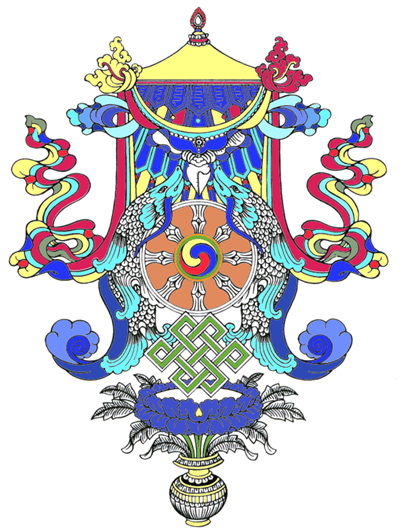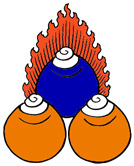| |

Studies
in
Buddhadharma
The Four Seals :
Are You (not) a Buddhist ?
 Contents
Contents  SiteMap
SiteMap

Impermanence
Dissatisfaction
Emptiness
Nirvâna
|
|

The Eight Auspicious
Signs |
|
|
What is the view of
Buddha
Śâkyamuni ? Or : How can we
swiftly & precisely answer the questions : "Am I (not) a Buddhist ?" The
primary concern of Buddhism is
wisdom, the
mind realizing
emptiness, the true nature of phenomena. Ethics is a preliminary.
This wisdom mind has "the right view". One who has "right view" is,
in principle, a Buddhist. This "right view" is a fourfold set of
tenets each having to be affirmed (or negated) to be a Buddhist
(or a non-Buddhist).
These "Four Seals" authenticate any system of thought as truly
"Buddhist", establishing it is part of the
Buddhadharma beyond
any possible doubt :
-
impermanence
: all
fabricated, compounded, assembled things or entities-having-parts arise,
abide & cease; i.e. are impermanent and so constantly changing ;
-
suffering :
all contaminated phenomena are painful & unsatisfactory ;
-
emptiness
: all phenomena
are without inherent existence, i.e. exclusively other-powered ;
-
nirvâna
: is true,
ultimate peace, in other words, suffering may cease.
Given these Four Seals, one
is not a Buddhist :
-
If one accepts things are self-powered, possessing
their own, essential, substantial, unchanging nature, a final ground "cut
off" and independent from all other self-powered things.
-
If one accepts contaminated things (like afflicted &
non-afflicted emotions & mental obscurations) are pleasurable, really
satisfying one's cravings.
-
If one accepts every thing appears as it is, i.e.
substantial, self-powered & inherently "cut off" from all other things.
-
If one thinks the fruit of spirituality (enlightenment)
exists within the spatio-temporal world-order(s).
|
The view is the core of any religious system. It is the
final reference point defining whether a physical, verbal or mental action
(like thoughts, emotions or volitions) is justifiable in terms of the
system. In classical logic, when two systems cherish radically different views, they
cannot be said to be both true. So before starting debate, the
participants need to agree on the logical system they will use. Both
Western & Eastern philosophy accept the rules of classical logic (with its
identity, non-contradiction & excluded third). Despite the fact these
basic principles may just be an exception of the more general case of
quantum logic, we need them to first clear the mind from common sense
delusions.
Take Mediterranean spirituality. Although polytheism,
henotheism &
monotheism entertain different concepts of the Divine, they share the
theist axiom and so posit a Being so Supreme it is entirely
self-powered, ultimately existing from its own side, absolutely sovereign
and so fully in control. Omnipotence is the core feature of this Supreme
Being. As absolute absoluteness, it is so ultimately perfect for it to
necessarily exist & necessarily create, for non-existence would make it less perfect. In
Platonic style, this Supreme Being equals Supreme Existence (cf.
Does the Divine Exist ?, 2005). Likewise, the sophisticated schools of
Indian philosophy (like Sâmkhya, Yoga & Vedânta) also introduce a Supreme
Creator, Brahman manifesting as Brahmâ. Only in the so-called "Dharmic religions", like Buddhism &
Jainism, is such a Supreme Creator not found, although some phenomena are
still called "Divine". The Dharmic religions are not atheist, but
nontheist, or better, transtheist.
Philosophically, only one view can be true. As wisdom, the fruit of right
view, is the heart of the
Buddhadharma,
both conventional and ultimate truth are its core business ("dharma" comes
from the verbal root "dhr", meaning "to hold, to carry, to possess"). Analyzing how
the superimposition of own-power works, the critical mind is able to
affirm radical nominalism. First in terms of the illusion of a permanent
ego, then unmasking the permanent others. Once this is done, the
assemblies or aggregates constituting every concept of the Divine are
deontologized (deconstructed). This purifies the conceptual mind. This
step is followed by training the ability to stop the production of
concepts at will, thereby resting in the acute awareness of the moment at
hand, clearly present in it.
Just like all other concepts, a concept of the Divine is functional,
but does not inherently exist "from its own side", i.e. as self-powered,
as it appears. Transforming this Supreme Being deemed an unchanging,
own-powered substance into an other-powered process-Deity calls for
the negation of its omnipotence, for as soon as interdependence is
accepted, sovereignty is lost. However, loss of omnipotence is not loss of
Supreme Generative Power through a infinitely vast network of
interconnected functional, co-relative events. On the contrary, no longer
a closed monad, Deity is the multiversity of one, pan-sacral, unbounded
wholeness.
This empty, omniscient but highly functional (interrelated) & interstitial Deity is the
object of Buddhist
Deity Yoga, the "turbo" method of the
Diamond Vehicle.
The views expressed by the Four Seals apply to the whole Buddhadharma.
Co-relatively, all paths or methods are also based on them. Anything which
contradicts one or more of the Four Seals is non-Buddhist. All four
need to be present for a teaching to belong to the Buddhadharma.
1. All Compounded,
Compositional Phenomena are Impermanent
Among parts, other-power
prevails, and so inherent stability & permanence of essence (substance)
cannot be found. All phenomena originate
dependent on unique causes and conditions (cf. "dependent arising" or
"pratîtya-samutpâda").
Subjectively, consciousness attributes conceptual meaning to sensate &
mental objects. This process of attributing, positing and designating labels to sensate
objects and those of thought, affect & volition, when correctly pursued,
gives rise to conventional truth. This truth is relative, provisional,
contextual and ever changing.
Criticism affirms how the conceptual mind, with its proto-rational, formal, critical &
creative modes of cognition, is unable to eliminate interpretation, ever
retracting from facing whatever there is ("dharmadhâtu")
and this because of the intervention
of a hallucinated "substantial" ego, a monolithic focus of consciousness,
an own-powered "reality-for-me". All these aggregates, sub-aggregates,
etc. are driven by processes and nowhere among assembled, compounded objects is
anything stable to be found. Sensate objects are ever-changing. Mental
objects are "given" stability by a volatile conscious intent.
The "ego" established by the first person perspective exists, but not as it
appears. It is not apart from or identical with the body. It exists as a
function of the aggregates. It merely rides the windhorse.
Objectively, material forms are constituted by particles and particles
are constituted by sub-particles, etc. The final ground, a virtual
quantum field,
is itself in constant movement, with particles shifting in and out of
"existence". Apparently, this flashing in and out of "existence" is the
fundamental basis of the "solidity" of sensate objects. This
process can only work
if no element in the assembly of aggregates cluttering from micro-, to
meso-, to macro-cosmos is "stuck", always resists change.
Because of the division in parts, an overall impermanence is at work, one not
excluding transient architectures.
2. All Afflictive Emotions
are Unsatisfactory
Emotions are
affects satisfying the needs of an ego without considering the other as
such. Non-afflictive emotions satisfy a selfish need without causing harm,
like eating wholesome food properly cultivated by oneself to appease hunger.
But afflictive root-emotions ("kleśa") like hate, greed, stupidity,
exaggerated attachment (craving), arrogance & pride cause massive harm.
Feelings like joy, gratefulness, love, compassion etc. are affects
always satisfying needs both ways, through harmony, symmetry and reciprocity.
They are non-afflictive. But in the long run, they too are prone to change
and so fundamentally unsatisfactory. They do not provide lasting, irreversible peace, the end of craving &
hatred, of grasping and rejecting. And this is what the Buddha found :
lasting, true peace.
Owing to this instability, this coming to an end or ceasing of objects,
sentient beings live woefully. Conversely, owing to the selfsame
instability etc. Buddhas dwell at ease (cf. Samyutta-nikâya).
Liberation from suffering is dependent on the very nature of suffering
itself. Indeed, all woe is interdependent and not self-powered.
3. All Compounded,
Compositional Phenomena are Empty
The fundamental error of
ignorance consists in reifying the data of the senses as well as the
objects of the mind. When this happens, objects are established by way
of their own character. Because something is functional, i.e. able to
"work" or perform a certain task, the deluded mind thinks this functional
objects must exist in a permanent, ultimate, substantial, independent and
essentially own-powered way, as it were "cut off" from its environment and
other objects. The conceptual mind designates (projects) ontological
auto-sufficiency on its objects, attributing to them the capacity to arise,
abide & cease independent from anything else. To view
this self-power or self-nature as the ultimate truth, leads to wrong actions, causing
afflictive emotions, ending in endless forms of suffering &
unsatisfactoriness.
In truth, all phenomena are other-powered, i.e. under the influence of
conditions & determinations (like causes) other than themselves. If they
were own-powered, they would not be able to perform functions at all !
Here, "unchanging" means permanent in all dimensions,
without exception, even after thorough, so-called "ultimate" analysis.
Ultimate truth sees all
phenomena as devoid of substance, permanence and independence. Every
sensate or mental object arises, abides and ceases according to causes and
conditions and so every conventional reality is provisional, only "for
now". Because we experience functioning things, this does not mean these
experiences and their related objects exist in an "ultimate" way, namely
as they appear. The ultimate reality of every phenomenon, its emptiness,
is precisely the lack of inherent existence. In classical logic, this lack cannot affirm
anything else except this absence of substantiality. It implies a
non-affirmative negation, leaving no choice. Itself devoid of
inherent existence (the emptiness of emptiness), emptiness is not the
"substance" of phenomena. Hence, emptiness is the ultimate characteristic of every
single phenomenon.
"Samsâra" without reification is "nirvâna".
Appearances are not binding, but one's substantializing attachment to them is.
4. Nirvâna is
Peace
In any rational presentation of the ultimate nature of
phenomena, the difficulty consists in that our languages are steeped in
the Aristotelian distinction between substance and quality. Consisting
largely of nouns, anything designated by way of language becomes "a
thing", i.e. an "ousia" (substance) with properties. By extension, the
"world" is designated as made up of physical and mental objects. Adding
adjectives to qualify a noun, we add "thingness" and perform an
entitative, static reduction of the ultimate nature to the conventional
nature of phenomena.
This may also happen with "nirvâna",
called in the Pâli Canon
"a place hard to see", "an island in a stormy sea", "a dimension that
cannot be localized" or "a foothold that does not slip" etc. In a
structure-oriented approach of the path, "nirvâna" is linked with a
conception of a process having come to an end (cf. the image of a flame
becoming extinguished). The goal is an end state and in many ways
resembles a dead end, which is not the case. Considering ultimate truth
thus, is projecting it out of the present moment into a very far (or near)
future. This is precisely the way the deluded conceptual mind works.
The same reification may happen when the adjective "Buddha" is used as a
noun. As a past participle of the verb "budh", or "to awake", it does not
denote a thing of the world, neither a static, experiental "state" of
being "fully awake". Hence, "the Buddha" is not some object, and is best
not approached by way of a view positing "states" and "structures".
Instead, just like "nirvâna",
Buddhahood points to a continuous,
never-ending process. In the
Mahâyâna,
"nirvâna" is equated with the ultimate state of the
Lesser Vehicle,
i.e. Arhathood, involving personal
liberation or the release from "samsâra",
the cessation of personal suffering.
Buddhahood, implying omniscience, is a higher
state, achieved by generating
Bodhicitta, the
intention to enlighten all sentient beings, not just oneself.
In Tibetan Buddhism, seeking the sense rather than the literal meaning,
"Buddha" is translated as "sangs-rgyas". "Sangs" means "wiped out,
cleansed, purified, awakened, free from", and "rgyas" means "increase". A
classical Mahâyâna interpretation would be to say a Buddha removed
what is to be removed, and increased what must be increased.
However, is there, at the end of this process of removal and increase,
anything more to be done ? Does this interpretation not again frame a
static understanding of
Buddhahood and true peace ?
Buddha
Śâkyamuni does not seek a heaven or an unchanging,
problem-free area, a sophisticated, subtle existence similar to our
current one, but one without trouble, problems, suffering, etc. The
Buddhadharma has no salvic topology. In fact, "nirvâna"
is not a place at all. It falls outside space, time & conceptualization
and so cannot be compared with the many heavens of the ancient or
contemporary religions, whether they be Ancient Egyptian, Pagan, Hindu or
Abrahamic. It is not companionship with Osiris or Re, not a realm of
Devas, not a Garden of Eden. These are all reified states, based on the
hope to continue conventional existence ad aeternam. Buddhahood is
beyond the Arrow of Time. Given a calm mind & a good heart, this can be
prehended in the sheer actuality of every moment.
Although entering "nirvâna" may be understood as a joyful state of bliss,
this station-of-no-station is beyond happiness and unhappiness. The
ultimate is a release from the chains of ignorance and its delusions. The
way of the Buddha does not lead to happiness, but to freedom from
suffering by being free from ignorance and its confusions. It leads to
a blissful state devoid of happiness & unhappiness, to true peace. This is possible because
the ultimate nature of sentient beings has, is and will remain enlightened.
This Buddha-potential is a given, and
so does not need to be acquired. The stains or obscurations covering it
need to be removed (or, in other words, the emptiness of the mind has to
be thoroughly realized). That is all. Entering this unbounded wholeness leads
to unending symmetry-transformations.
Although the deluded mind considers a dirty glass as inherently "dirty",
it is only dirty because of the dirt & the fingerprints on it. Wash these
off, and the original, clean glass emerges. Likewise, "nirvâna" is not to
be attained, it is to be (re)discovered, or better, recognized. The glass (Buddha-potential) is not
inherently dirty. If the glass were inherently dirty, then one has to get
rid of the glass itself and replace it by a "pure" glass. But this is not
the case. We only need to make the effort to remove the impurities appearing on the glass due
to transient causes & conditions. When this is done, the original glass
arises. This is not a tranformation, but a mere elimination, like blowing
away the clouds shielding the light of the Sun.
The Buddha affirms it is
possible to remove what obscures. We should trust having Buddha-potential. He
does not teach us to wash our dirty clothes with mud-water or blood with
blood. By
accomplishing the elimination, awakening happens. The word "Buddha" can be
defined as having the aspects of "accomplishment" & "awakening".
Liberation and recognizing ultimate truth are simultaneous.
Despite sublime poetry, enlightenment cannot be conceptualized.
It is the result of the exhaustion of defilements and the exhaustion of
the antidote of the defilements. This is what reason teaches.
Moreover, being empty of stains, once the potential actualized, it is
also full of Divine Buddha-qualities.

|
|




